Early summer storms; preparation for impending heat wave; brown patch and leaf spot arrival; zoysia/bermudagrass winterkill and disease activity
Weather
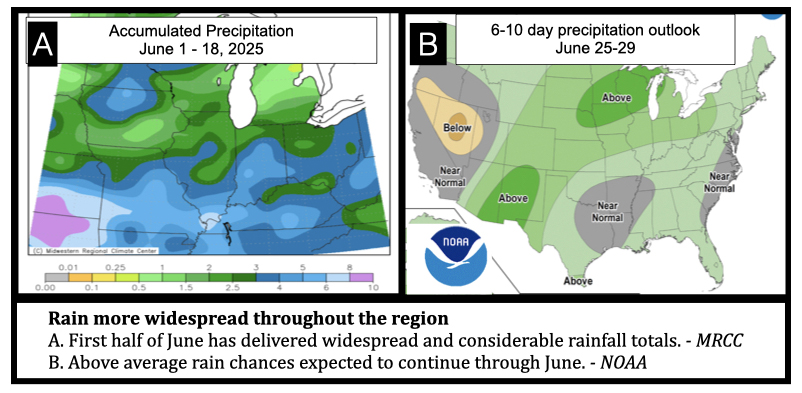
Yesterday’s storms produced a wallop in the region, with extreme winds felling trees and lodging corn. A wet first half of June followed a May with extreme rainfall in the south (Lexington, KY – 4th wettest May on record; Evansville, IN – 6th wettest) and much lower precipitation in the north (Fort Wayne – 11th driest; Chicago – 12th driest May on record). Quite the division of naturally delivered water from north to south. June rainfall has been a bit more widespread, with areas nearer to Lake Michigan still running in a bit of a deficit, especially compared to the swimming pool south towards the Ohio River.
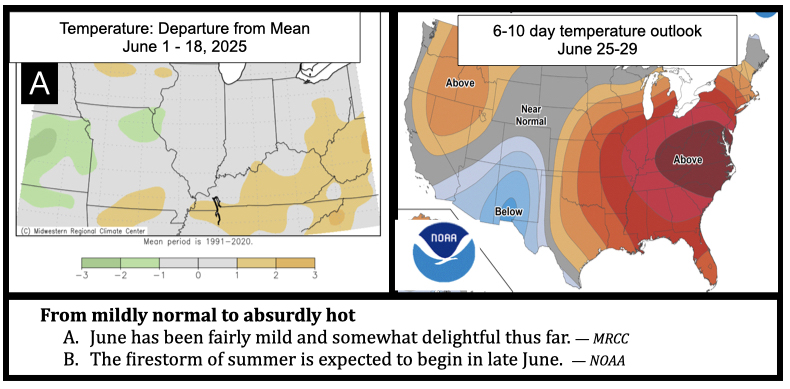
Temperature has been exceedingly normal in much of the region for the first half of June. May temperatures were also at or below normal for much of the region, with no large flamboyant jumps in high temperatures. This is set to dramatically change as Mother Nature is breaking out the feathered boa and will be delivering intense heat over the weekend and into the rest of June. This stress will be a stressful shock to our cool season turfgrasses and perhaps give a reprieve to those in the south attempting to encourage warm season grasses back to life.
Impending Heat Wave Preparation – Cool Season Turfgrasses
In a conversation with a golf superintendent earlier this week, he relayed an impending feeling of doom that this was the last real week of spring. Conditions will be “flipping the switch” towards summer stress and the need for both sweat and skill in turfgrass maintenance. The balancing season of keeping grass healthy is definitely upon us, but preparations conducted during spring (i.e. mindful fertilization, restrictive irrigation adaptive to rainfall, clipping management, golf – root disease prevention, etc) discussed in earlier reports hopefully has widened the tightrope with healthy turfgrass having a developed root system.
Water – Use Irrigation Wisely
Prior to next week’s heat, locations nearer to Lake Michigan have a distinct advantage, other than their more prized latitude. These areas have been drier, meaning root systems have not been constantly saturated and limited by a lack of oxygen, and should therefore be more extensive. The experienced manager understands that having some control over the amount of water delivered to turfgrass under their purview is perhaps the most important aspect of reducing leaf aches and headaches. Adequate drainage and water management is essential for fast, high quality golf putting greens and sports fields, which are maintained at the highest maintenance levels of perhaps any plant on this planet
Don’t misunderstand, rainfall is the most effective form of irrigation. If we could get 0.5 – 0.75 inches a week measured out in steady measured doses, it would indeed be perfect. However, like anything else the dose makes the poison. Heavy, flooding rains deliver inches at a time, and turfgrasses (particularly on heavier soils) are provided little favor. Overirrigating in the spring creates a false sense of security, since a lawn with a compromised root system can stay lush in these times of optimal temperatures. When the bottom drops out, meaning the temperatures rise towards demanding, the underdeveloped root system can’t cash the check because it doesn’t have the savings.
Water has a higher thermal conductivity and thermal specific heat capacity than air. This means when water gets hot, it stays hot and makes that environment hot. Overirrigating on a poorly draining soil or a plant with a poorly functioning root system to remove the water, can raise soil temperatures and keep them there, particularly at night when air temperatures finally grant a reprieve from the long summer’s day. At this point, be mindful of irrigation practices past and present and how they are impacting your managed areas.
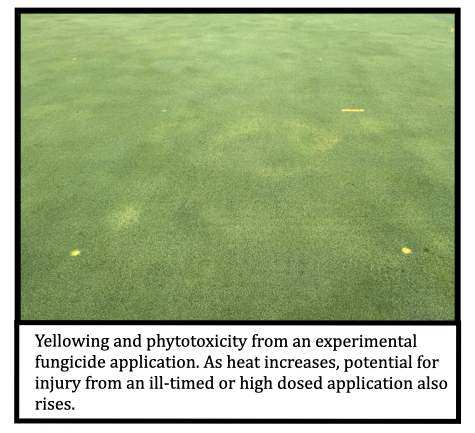
Phytotoxicity
This week we had our first occurrence of phytotoxicity from one of our experimental fungicide treatments on our research putting green. These plots had been sprayed twice this season, and we are unsure of the compound or mechanism that added the stress. The symptoms appear very much like suspected bacterial decline with an obvious chlorosis and some mild etiolation prior to mowing. Also, some segregates of ‘Pennlinks’ could be taking it on the chin more than others within the plot.
This is a great reminder that we can be our own worst enemy. Herbicides with stated heat restrictions are an obvious threat and knowing the label prior to an application is a must. My experience is we simply try to do too much to stressed turfgrass. One more biostimulant, one more fungicide, one more wetting agent, one more micronutrient, one more this and one more that. Something will surely make that grass run faster during the seventh hill of the marathon. Within a blink, there are 5, 7, 8, 10, 14 (my observed record) products in the same tank.
In our research plot, we sprayed ONE active twice and got a reaction under relatively mild temperatures. How does a high number of products react in the tank, on the plant and in the plant when temperatures eclipse 90 F? Experiments with all of the different tank-mix permutations in a high stress environment have not been done. The logistics are simply impossible with the substantial number of products and possibilities on the market. On lawns with lesser inputs, this shouldn’t be as much of an issue, but on golf putting greens I find it ot be
My advice is that taking products out of the spray tank during heat stress is often more beneficial than putting more in. Importantly, also monitor the amount of sulfur on putting greens in the products in the tank. High sulfur inputs can spark black layer and turf loss in hot, saturated soil conditions very quickly.
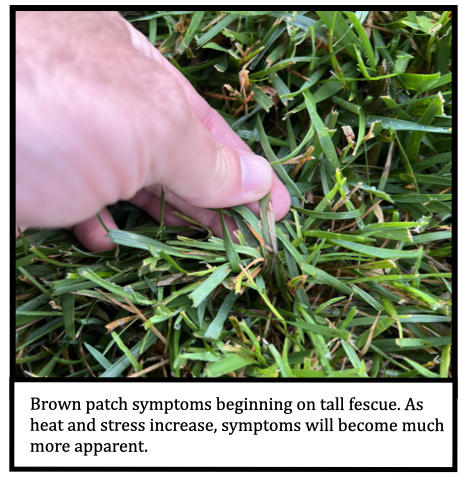
Diseases – Symptoms Getting More Obvious
Brown patch on tall fescue has been lurking for the last few weeks and is becoming more and more obvious on our plots. Disease symptoms on home lawns will become much more conspicuous in the next few weeks. On home lawns, fungicide applications can often be made curatively, particularly if plant health is good going in.
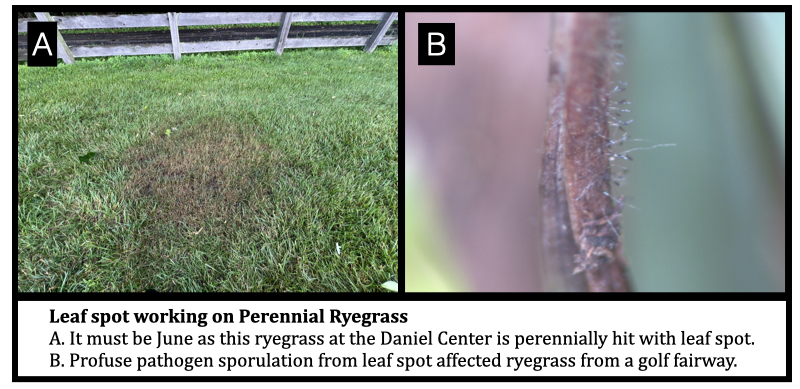
Along with brown patch on tall fescue, leaf spot on perennial ryegrass was found on a patch of fairway height grass in southern IN and in our normal spot along the fence at the Daniel Turfgrass Center. This observation is not gray leaf spot but instead caused by the older termed Helminthosporium (Bipolaris or Drechslera) pathogens with the common disease name of leaf spot/melting out diseases. These pathogens can also damage Kentucky bluegrasses and caused severe symptoms last year (click here to view the previous report). The time is here to scout lawns and all turfgrass areas intensely. At our upcoming field day, we will concentrate on identifying these lawn diseases and how to manage them.
Zoysiagrass/Bermudagrass Winterkill & Disease Activity
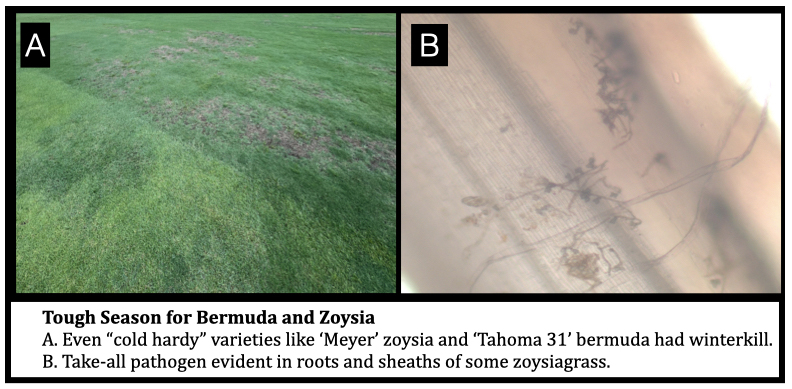
The unfortunate story of this past winter and spring is the poor state of warm-season turfgrasses. On many courses, both zoysiagrass and bermudagrass took it on the chin and is struggling. Low temperatures during the winter are primarily blamed on these kills, but the corresponding high spring rainfall events in areas with considerable loss also point towards saturation during greenup as playing a role. Even cultivars such as ‘Meyer’ zoysiagrass and ‘Tahoma 31’ bermudagrass incurred significant damage on some courses along the Ohio River valley. While this report offers little in the way of solution, know that if you are dealing with this that you are not alone.
On the disease side, large patch on zoysiagrass (and probably bermudagrass) is still being observed in the region. Superintendents have reported making two tebuconazole applications last fall, an additional two applications this wet spring, and still have activity in mid Junr. In a visit this past week, quite a bit of take-all root rot was observed in chlorotic and still declining samples taken from low lying zoysia areas. The pathogen (Gaeummanomyces spp.) wasn’t limited to the roots in these samples but was also very predominant on the leaf sheaths. Tebuconazole is the most often reached for fungicide in controlling large patch, but take all root rot on zoysiagrass, which is not as well studied, may require a strobilurin fungicide addition. A final disease of note on zoysiagrass is yellow tuft or downy mildew, which is also not well studied.
On the good news front, the temperature hike will be welcome and hopefully allow for quick recovery from rhizomes and stolons. Dr. Aaron Patton at Purdue is a principal member of a multi-university team studying zoysiagrass adaptability and use. If you have experienced winterkill, please consider filling out this quick 5-minute survey to let this research team learn more about the situation this year.
2025 Bermudagrass/Zoysiagrass Winterkill Survey
Additionally, this large team recently wrote an extensive review of bermudagrass winterkill with the current knowledge of the condition and its management strategies. To access this free article, click below.
2025 Purdue Turfgrass & Landscape Field Day
Last but not least, registration for the field day is open! Join us for a ton of education packed into a single day, outside, with all of your likeminded friends. On the pathology side, we’ll discuss lawn diseases, interseeding of golf fairways, and disease scouting on golf putting greens. Other learning opportunities regarding turfgrass fertility (Drs. Cale Bigelow and Jada Powlen), weed control (Dr. Aaron Patton) and insect control (Dr. Richmond) will be presented, along with valuable information regarding trees, ornamentals and other landscape items. Hope to see y’all there.
Purdue Turfgrass and Landscape Field Day – Tuesday, July 8th
Lee Miller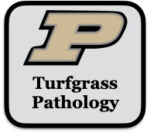
Extension Turfgrass Pathologist – Purdue University
Follow on Twitter: @purdueturfpath